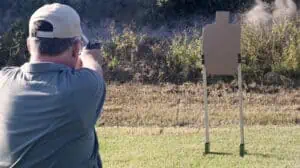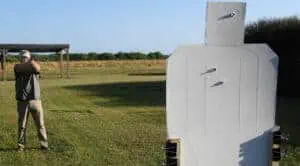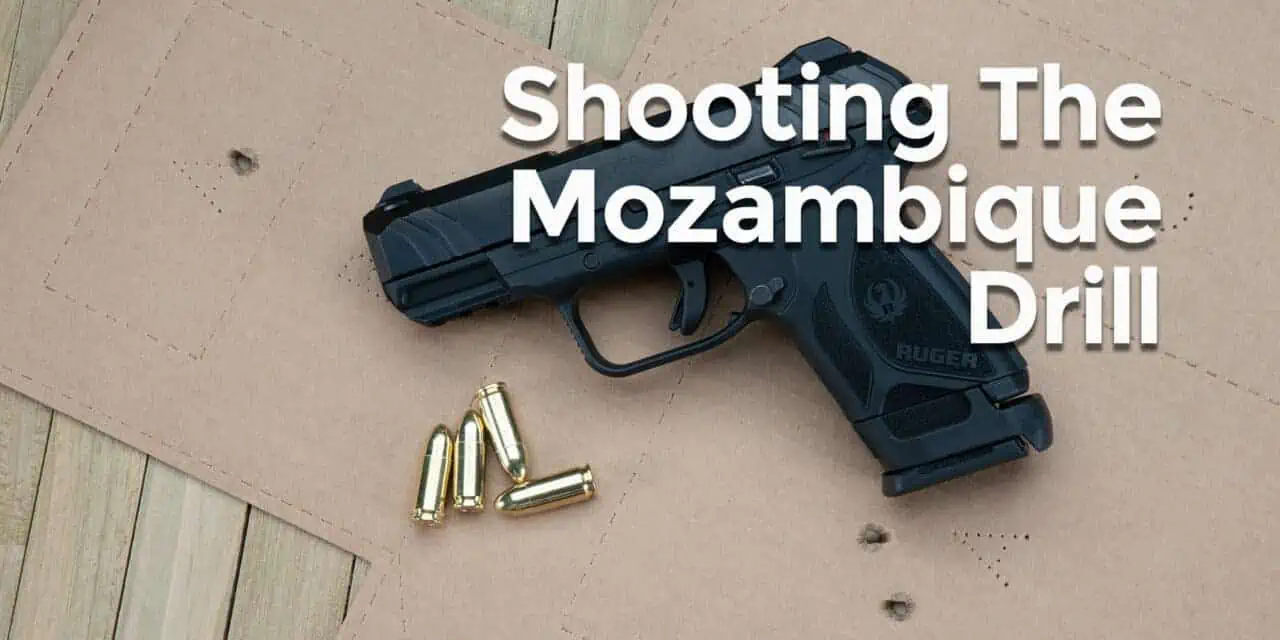The Mozambique Drill: Making The Stop More Certain
A defensive pistol’s small size and your ability to carry and conceal it comes with a price. Pistol caliber cartridges, even larger ones like 10mm and .357 magnum, just don’t have the same effect on the target as a rifle round. This means we have to train to make multiple hits on our target with our pistols. Ideally, we’re getting hits in the upper chest region where the important bits are. But what if even that is not enough to stop the threat to our lives? That’s where the Mozambique Drill, or Failure to Stop Drill, comes in handy.
Let’s pause for a moment and talk about our goals as armed citizens. We are not the police. It is not our job to go look for crooks and arrest them. Attacking and holding territory is also not our job; it’s the military’s. Our job is to stop the threat of imminent death or bodily harm to ourselves and those in our care. Our job isn’t to kill someone, it’s simply to stop the threat to your life. If that threat runs away because you suddenly produced a pistol, congratulations, you win. If they don’t, well, that’s what this blog is all about.
The reason why firearms trainers teach you to aim for the upper center chest (and why some targets are better than others) is because it’s full of the parts that will bring us to a grinding halt if they get damaged. The heart and lungs keep us going. If our lungs are poked full of holes, we tend to shut down. At that point, we’re not a threat to others.
Origins Of The Mozambique Drill
Note that I said “most of the parts” and “tend to.” There may be times when hits to the upper body aren’t stopping the threat. That’s when perfecting the Mozambique Drill comes in handy. The drill itself was born out of just such an incident that happened in, you guessed it, the African country of Mozambique. The country suffered through a bloody war of independence from 1964 to 1974, and mercenaries were often brought in to bolster the beleaguered forces on both sides.
One of those mercenaries, a man named Mike Rosseau, happened to round a corner in the midst of a battle and ran into another man on the opposing side armed with an AK-47. Rosseau drew his pistol and was able to engage his opponent with two 9mm rounds to the chest. Unfortunately for Rosseau, those rounds did not stop his opponent. Seeing this, Rosseau took careful aim and dropped the rifle carrier with a shot to the head.
That incident would have gone unnoticed in history if it weren’t for the fact that, years later, Rosseau spoke with noted firearms trainer Colonel Jeff Cooper. Col. Cooper was the founder and owner of Gunsite, the world’s oldest firearms school for armed citizens. He was a lifelong student of the gun. Rosseau’s tale intrigued Col. Cooper because it showed one of the inherent flaws of a pistol (limited firepower) and what you can do to stop it (go for the head shot). The Mozambique Drill became a standard at Gunsite, and has since spread around the world.
In recent years, the drill has become a popular staple in Hollywood Action movies. The John Wick movies in particular are known for having our hero dispatch his foes with two shots to the body and then one to the head. Tom Cruise also did a masterful job of both shooting from retention and performing a Mozambique Drill in the movie “Collateral,” which kinda went like this.
Only with better (much better) production values.
How To Shoot The Mozambique Drill
 The Mozambique Drill, as taught at Gunsite, is quite simple, and replicates the situation Mike Rosseau encountered in Africa.
The Mozambique Drill, as taught at Gunsite, is quite simple, and replicates the situation Mike Rosseau encountered in Africa.
- Set up a silhouette target at 7 yards. Whatever target you chose (I like the USPSA Metric Target) should have clearly-defined center-chest and ocular cavity regions.
- At the start signal (this is where a shot timer comes in handy), draw your pistol from its holster and fire two rounds to the upper center chest and then one to the ocular cavity of the head.
- A five second par time is a good time to aim for when shooting the Mozambique Drill at seven yards. Above-average shooters should be able to perform this drill in 2.5 seconds or less, from the holster. True experts can shoot it in around 1.5 seconds. For even more challenge, try shooting the drill from concealment, or back the target out to ten yards and try it there.
While the standard drill is shot at seven yards, the techniques in the drill are applicable at almost any distance. No matter the distance to your target, getting effective hits with your pistol is always a priority. Two rounds to the chest and one to ocular cavity can be shot at close distances with relative ease. However, at long range, that headshot can be quite difficult.
The ocular cavity, in case you were wondering, refers to the area of the skull roughly between the bottom of the eyebrows and the bottom of the nose. The skull bones are much less dense in this area. This means that a round that hits in this area has a very good chance of going right through to the brainstem and stopping your attacker.
Mozambique Drill Variations
As originally created, the drill requires you to draw from a holster. However, not everyone has access to a range that allows that sort of thing. If you can’t draw from a holster, go ahead and shoot the drill from the low ready position. The first two shots to the upper chest need to be done as quickly as possible. However, you might be at a range that has a fixed shot per second count. If that’s the case, concentrate on making those first two shots as accurately as possible. The speed will come, and if your accuracy is already there, you’ll get your hits.
 On that same topic, the hit area for the third shot in the drill is quite small, smaller than the upper chest area. Making that shot, on demand, can be quite a challenge. This is why the lessons of the Mozambique Drill aren’t just for soldiers of fortune in far off, exotic countries. Rather, they’re for all of us who carry a defensive pistol. Let’s look at some of them.
On that same topic, the hit area for the third shot in the drill is quite small, smaller than the upper chest area. Making that shot, on demand, can be quite a challenge. This is why the lessons of the Mozambique Drill aren’t just for soldiers of fortune in far off, exotic countries. Rather, they’re for all of us who carry a defensive pistol. Let’s look at some of them.
AKA, The Failure To Stop Drill
The reason we also call the Mozambique Drill the Failure To Stop Drill is because of two Los Angeles Police Department officers, Larry Mudgett and John Helms. In 1980, they took a class at Gunsite and wanted to start teaching the Mozambique drill to their fellow SWAT officers. The officers wanted to avoid any problems with the communities they were policing, so they changed the name from where it first happened (Mozambique) to what problem it solves (Failure to Stop).
Think While You Shoot – Legal Implications
We want to be in as much control of our intellect and emotions when all other options have failed and we are forced to defend a life with lethal force. The last thing that any of us wants to say is, “Why, no, Your Honor, I don’t remember how many shots I fired, because I was in a blind rage at the time.”
That is NOT going to help you in court.
We want to be able see and react to what is happening around us in a defensive encounter. Did an innocent bystander just walk into the line of fire? Did the bad guy’s friends show up and complicate the situation even further? Evaluating what is going on in the gunfight is built into the Mozambique Drill. It’s a good habit to bring into other areas of shooting as well.
Be Prepared To Change Your Plan Of Attack
The stresses involved with a defensive encounter take a heavy toll on our brain. The adrenaline dump from having to defend a life alters our perception of time and can cause tunnel vision. Tunnel vision narrows all our perceptions (not just sight) in on the source of the threat. This, in turn, can force us into pursuing a course of action in a fight long after it ceases to be a viable option. The pause in the middle of the Mozambique drill forces us to break our concentration on the task at hand. We have to refocus our attention on a new task. This in turn makes us safer, more effective gun owners. The Mozambique Drill teaches us to pay attention to our hits and to alter our current course of action if needed.
The Mozambique Drill is one of the classic pistol drills, and for good reason. It does more than just teach you how to put hits on target. It helps teach the fine balance between stopping the threat in a judicious amount of time and getting your hits where they should be to stop the threat when needed.


